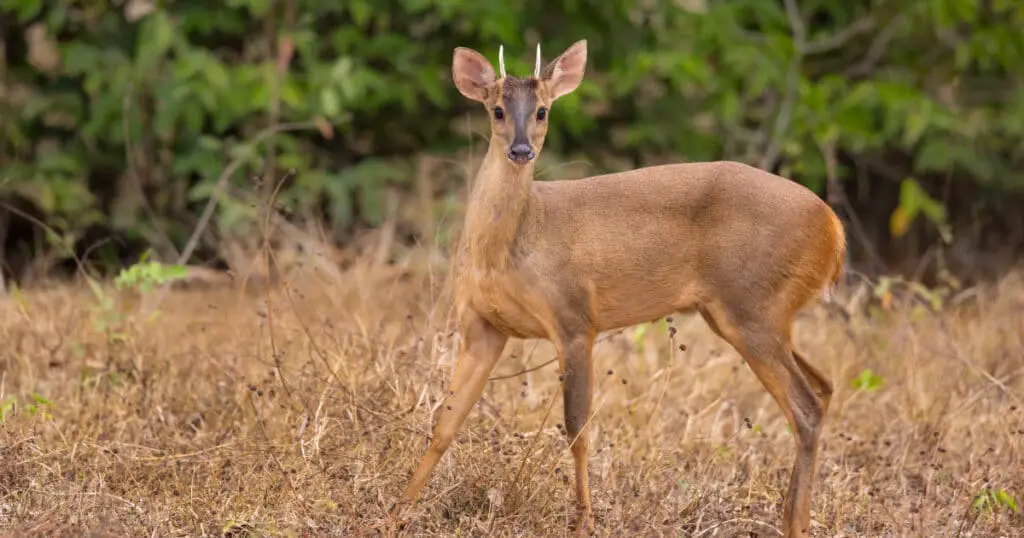There are several different types of unique Brocket Deer which together fall under the genus Mazama. Found on the Yucatan Peninsula, Central and South America, and on the beautiful island of Trinidad, there are 10 confirmed species of Mazama deer — all small to medium in size.
On this page we’ll share information and photos of Brocket Deer to introduce you to this unique and beautiful deer.
What Size are Brocket Deer?
Table of Contents
ToggleAs we just mentioned, there are actually 10 different kinds of Brocket Deer, so the measurements of each species varies slightly.
With that said, most Mazama deer fall within this general size range:
- Head & Body Length – 70 to 140 cm
- Shoulder Height – 40 to 70 cm
- Tail length – 5 to 20 cm
- Weight – 8 to 30 kg.
What Do Brocket Deer Look Like?
There are a number of Mazama or Brocket Deer species, all fairly similar in appearance and with similar behaviors.
Because of these close similarities, on this page they will be considered together. What normally applies for one species of Brocket, applies in most cases to the entire Mazama genus.
Mazama deer are small forest dwelling deer. They have small rounded bodies, with the hind parts carried higher than the fore legs and front end.
In coloration they tend to be a light or dark brown. This varies slightly from one type to the next.
The antlers are short fairly simple spikes, which tend to be kept a long time before they are shed.
Some of the most common types of Mazama deer include:
- Red Brocket (Mazama Americana) – This is the largest species of Brocket Deer, weighing up to 30 kg. It has a reddish-brown coat.
- Brown Brocket Deer (Mazama gouzoubira) – The coat is more greyish than in other species.
- Dwarf Brocket Deer (Mazama chunyi) – This species is a reddish-brown colour and has prominent eye glands.
- Little Red Brocket (Mazama rufina) – One of the smallest species, the coat is a grey to reddish brown colour, the underside is white.
- Merioa Brocket (Mazama bricenii)
- Pygmy Brocket (Mazama nana)
- Yucatan Brown Brocket (Mazama pandora)
Where do Brocket Deer Live?
Brockets can be found throughout South America, where they have a wide distribution and are found everywhere apart form the Pampas grassland areas of the South East.
Red and Brown Brockets have wide distributions and are found throughout the continent. They are very common.
The Dwarf Brocket, Little Red Brocket and Merioa Brocket are found in the Andes region of the northwestern part of the continent, and have much smaller ranges.
The Pygmy Brocket is found in Southeastern Brazil and surrounding areas, while the Yucatan Brocket is found on the Yucatan peninsula of Mexico (as its name suggests.
Preferred Habitat of Mazama Deer
Brocket Deer are predominantly woodland and forest dwelling deer, although they will also inhabit more open areas that offer a good level of cover such as scrubland and thickets.
Mazama deer are well adapted to living in thick vegetation. Their small bodies allow them to quickly scuttle around the forest floor and evade predators.
Unique and Notable Behavior
All the Brocket species of deer have similar lifestyles and behave in similar ways.
They are shy and secretive animals. It is rare to see Brockets because of this deer’s nocturnal habits. Mazama deer are not gregarious, living either alone or in pairs.
They normally live within a small territory, marking the boundaries with either with feces or urine, or with eye gland secretions.
Brockets rely on their small size and knowledge of the habitat in which they live to escape predators, diving into thick vegetation when detected. They are hunted by predators like the Puma and Jaguar in South America.
Brocket Deer eat mostly foods they find within their forest home, including fruits, leaves and shoots.
Mating & Reproduction in Mazama Deer Species
Male Brocket Deer normally mate with females that live in close proximity to them. Males will compete with each other for access to receptive females by biting and trying to stab at each other with their short antlers.
Sometimes Mazama deer will choose to live in permanent pair bonds.
Mostly the Brocket Deer are tropical living, and therefore have no fixed breeding season, but in more temperate parts of their range there is a distinct rutting season in the autumn months, as is common in other species of deer.
The gestation period for these deer is roughly 200 to 220 days, with normally a single fawn born.
Like many other types of deer, the Brocket leaves its fawn to lie concealed in thick vegetation. Mothers visit their fawn regularly. Once it is large enough to flee predators, the fawn will accompany its mother until she bears another fawn.
Weaning typically occurs at around 6 months of age in Brocket Deer.




